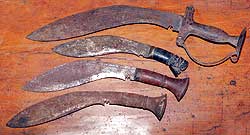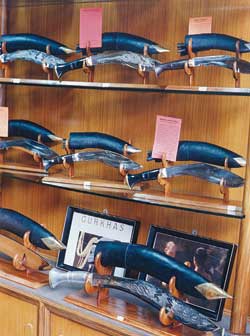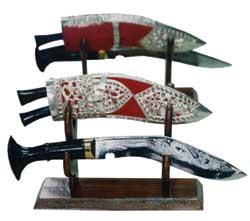
It's time to forget about the machete, the scimitar and the stiletto. More than any other weapon that has made a name for itself on the battlefield and off, the khukuri looms large in the annals of war. But over a century after Reverend Wood wrote his observations of the Gurkhas and their fearsome khukuris (see box) the Royal Nepal Army is amassing AK 47s and SLRs to fight the Maoists.
The khukuri, which terrorised the enemy during Nepal's battle with the British in 1814, and then again during both the World Wars, figures nowhere in a collection of modern weaponry. Even in the Imperial War Museum, there is only a small khukri in a glass case to remind visitors of this remarkable weapon.

"There is little use for the khukuri in modern warfare," says Lalit Kumar Lama, an ex British Gurkha officer now a dealer in Gurkha knives. "But it remains a symbol synonymous with the Gurkhas and with Nepal."
 The Khukuri House, Lama's showrooms at Ekantakuna and Thamel, offer a range of 22 khukuris, the largest being the buff-head khukuri, that boasts a 53" long blade, and the smallest a paper knife measuring about 6". Prices for these khukuris, some of which are not very different from the standard issue military knives, range from Rs 150 - Rs 4,000.
The Khukuri House, Lama's showrooms at Ekantakuna and Thamel, offer a range of 22 khukuris, the largest being the buff-head khukuri, that boasts a 53" long blade, and the smallest a paper knife measuring about 6". Prices for these khukuris, some of which are not very different from the standard issue military knives, range from Rs 150 - Rs 4,000. After retiring from the British Gurkhas in 1987, Lama, a former warrant officer got together with ex-armour sergeant Til Bahadur BK to set up a factory in Dharan to produce khukuris. Before that Lama used to buy khukuris made by more than 4,000 small khukuri producers in Dharan and sold them abroad. Since its establishment in 1991, the Khukuri House has been the official supplier of khukuris to British Gurkha units, the Gurkha Contingent in Singapore, the Gurkha reserve unit in Brunei and the British Museum.
The drop in British Gurkha recruitments since Hong Kong was handed over to China in 1997 doesn't worry Lama. About 95 percent of his customers-including those who purchase the Dharan-made knives online-are tourists. "They're moved by the history, the romance and the legends of bravery that surround the khukuri. Everyone who comes to the store takes back a souvenir," says Lama. In South Africa, it's even been put to practical purposes-to cut biltong, the dry meat favoured by South Africans. Lama has named this particular khukuri, which has a 5" long blade and a 3" handle, the biltong khukuri.
Although khukuris have traditionally been made by Kamis with little more than an open forge and a handful of tools, Lama's factory in Dharan has sought to modernise and mainstream their expertise. Some 300 artisans work here, building on the Kami community's hundreds of years of experience. The variety of khukuris they produce is astonishing-the Sirupate, named after the slim Siru leaf it resembles, the Dhankute from Dhankuta, which has a wooden scabbard and a wooden or aluminium handle, the Kothimara, a khukuri specially made for the retiring British or Gurkha officer as a memento from his regiment, and the Dehradune.
 Gurkhas, it is said, feel bare without their blade, and even though as a warrant officer Lama never wielded a khukuri against the enemy, he did use one to hack down branches to build a basha or shelter during jungle exercises, and learnt enough about the different kinds of military khukuris. The Jungle, an unpolished full-size khukuri, used for tactical jungle warfare, is 15" long, with a 10.5" blade. It weighs 600 grams and has a buffalo horn handle and leather case, and the sheath is camouflaged by green cotton cloth or camouflage.
Gurkhas, it is said, feel bare without their blade, and even though as a warrant officer Lama never wielded a khukuri against the enemy, he did use one to hack down branches to build a basha or shelter during jungle exercises, and learnt enough about the different kinds of military khukuris. The Jungle, an unpolished full-size khukuri, used for tactical jungle warfare, is 15" long, with a 10.5" blade. It weighs 600 grams and has a buffalo horn handle and leather case, and the sheath is camouflaged by green cotton cloth or camouflage. The Service No 1, probably, the most famous khukuri, is issued to every Gurkha on enlistment and is retained throughout their army career. It measures 15" and weighs 700 grams. The sheath is buffalo leather and the handle, buffalo horn. The khukuri is inscribed with the year of enlistment, a detail which helped some young Gurkha soldiers training in Malaysia identify an old Gurkha soldier who had been living in the forests since World War II, rather out of his mind. "At first they thought he was a bandit, but later they were able to identify him-because of his khukuri-as a Gurkha soldier who had fought in the world war and been left behind," says Lama.
Made from reinforced steel, mostly salvaged from railway track construction, the Dehradune or World War khukuri, originated in Nepal and was later emulated by the Indian Gurkha Army in Dehradun during World War II. This was the only khukuri used in the war, and Nepal was unable to keep up with the demand, which was when Dehradun started to produce these on a massive scale. The Dehradune has a 12" long blade with a 5" handle mostly of Indian rosewood or horn, and a scabbard is of buffalo leather.
Since railway tracks, and the materials to build them, are hard to come by in Dharan, Lama's factory uses the spring sheets of cars and trucks. Kamis generally heat the metal in a fire and temper it in a tea kettle. This may not sound very impressive, but tests show that khukuri steel is just the right hardness to cut through almost anything, including bone, with relative ease, while still remaining soft enough to take this kind of abuse and keep a decent edge. This is why khukuris function more like extremely good quality high-grade carbon steel kitchen tools than one might imagine.
Little is known of the khukuri's origin or its unusual shape. Some compare it to the Afghan knife, and others believe the blade form descended from the Greek kopis which is about 2,500 years old, thus making the khukuri one of the oldest blade forms in the history of the world, if not the oldest. The shape is believed to have been carried to the sub-continent by the troops of Alexander the Great and then copied by local workmen.
 There are khukuris hanging on the walls of the National Museum in Chhauni that are 500 years old, dating from the time of King Dravya Shah (1559-1570). Along with the katari (a kind of spear), the khadga (a blunt sword), and the khuda (a curved broad sword), the khukuri has been present in every collection of weapons of Nepal's famous fighting men including Amar Singh Thapa, Bal Bhadra Kunwar, Kalu Pandey, and Bhimsen Thapa.
There are khukuris hanging on the walls of the National Museum in Chhauni that are 500 years old, dating from the time of King Dravya Shah (1559-1570). Along with the katari (a kind of spear), the khadga (a blunt sword), and the khuda (a curved broad sword), the khukuri has been present in every collection of weapons of Nepal's famous fighting men including Amar Singh Thapa, Bal Bhadra Kunwar, Kalu Pandey, and Bhimsen Thapa. Khukuris may differ in size, but vary little in shape. Most are named after the places they come from. The famous Bhojpure khukuri originates form east Nepal. Slightly bigger and heavier than the standard blade, it is not a military issue, but is found in many Nepali homes, especially in east Nepal. "The 11" blade, is mounted on a 4" wooden handle that is often engraved with dragons that reflect the craftsmanship of the Bhojpure people," says Lama.
Almost every bit of a khukuri has a name. The two-part notch at the end of the blade is called the kaudi, which is translated somewhat gorily as "blood dripper", and is meant to prevent any liquid-such as blood-from dripping back on to the handle so the user can hold on to the knife. Although there are many models of blades, most khukuris come with what look like two mini khukuris-the chakmak, which is used to sharpen the knife, and the karda, a utility mini-knife.
There are plenty of explanations that attribute spiritual and religious significance to the khukuri. The kaudi, for instance, is said to symbolise Shiva's trident, or the Nepali sun and the moon. The buttcap of the knife, called the chapro, is said to resemble the eye of god, and the very shape of the blade, the crescent, is supposed to be an invocation of the Nepali moon. Among the other beliefs associated with the khukuri is the belief that Newar artisans should never touch one.
Right now, a different kind of aura surrounds the khukuri, one that is significantly less pleasant than mythological stories, and much more in tune with the times. Lama's factory in Dharan is now focusing more on taking good care of the stock it has-in its godown. "Since the emergency was first imposed, and a strict watch was mad mandatory over the transport of weapons, including the khukuri, by military forces who fear it may fall into the wrong hands, business has been slow," says Lama. That, and even the few tourists that do amble past his shop in Thamel are not sure they can take a khukri in their luggage in the post-September 11 security of airports around the world. You still can buy a souvenier khkuri, but you need to put it in your checked-in bags.
The Gurkha knife
 "The Gurkha is worthy of notice, if only for the remarkable weapon which they use in preference to any other. It is called the 'Kukri' and is of a very peculiar shape.
"The Gurkha is worthy of notice, if only for the remarkable weapon which they use in preference to any other. It is called the 'Kukri' and is of a very peculiar shape. . Before passing to the mode in which the kukri is used, it should be mentioned that it is not employed for domestic purposes, being too highly valued by the owner. For such purposes two smaller knives are used, of very similar form, but apparently of inferior metal. These are kept in little cases attached to the side of the kukri sheath, just as in the case with the knives attached to a Highlander's dirk.
In the hands of an experienced wielder this knife is about as formidable a weapon as can be conceived. Like all really good weapons, its efficiency depends much more upon the skill than the strength of the wielder, and thus it happens that the little Gurkha, a mere boy in point of stature, will cut to pieces a gigantic adversary who does not understand his mode of onset. The Gurkha generally strikes upwards with the kukri, possibly in order to avoid wounding himself should his blow fail, and possibly because an upward cut is just the one that can be least guarded against.
When we were engaged in the many wars in India the Gurkha proved themselves our most formidable enemies, as since they have proved themselves most invaluable allies. Brave as lions, active as monkeys, and fierce as tigers, the lithe wiry little men came leaping over the ground to the attack, moving so quickly, and keeping so far apart from each other, that musketry was no use against them. When they came near the soldiers, they suddenly crouched to the ground, dived under the bayonets, struck upwards at the men with their kukris, ripping them open with a single blow, and then, after having done all the mischief in their power, darting off as rapidly as they had come. Until our men learned this mode of attack, they were greatly discomfited by their little opponents, who got under their weapons, cutting or slashing with knives as sharp as razors, and often escaping unhurt from the midst of bayonets. They would also dash under the bellies of the officers' horses, rip them open with one blow of the kukri, and aim another at the leg of the officer as he and his horse fell together."
(From Travels in India and Nepal by the Reverend Wood, 1896)


